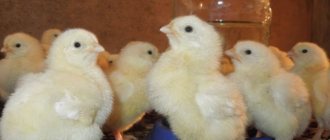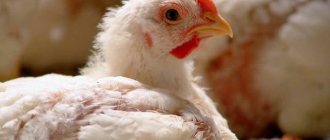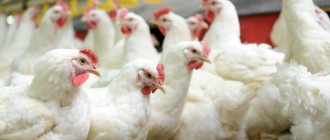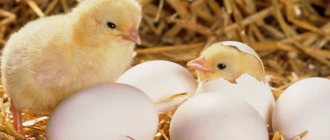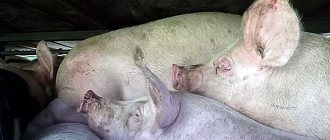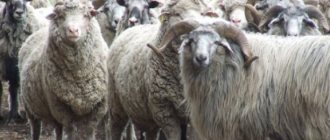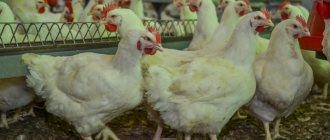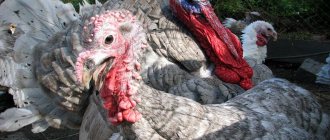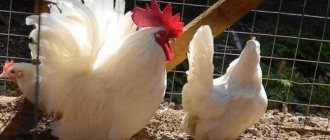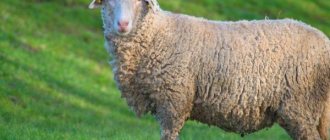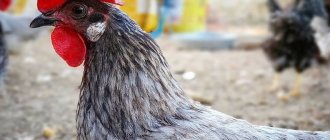Selection of meat breeds of chickens makes it possible to obtain strong crosses (hybrids) that are superior to the original individuals. One of the most productive examples is the Ross-308, which was developed by specialists from the British company Aviagen.
Ross 308 is a strong, fast-growing broiler with high meat performance.
The English hybrid is characterized by good survival, early ripening and unpretentiousness.
Feeding
Manufacturers recommend feeding ROSS-308 with special food, but you can replace it with homemade food, provided that it is of the highest quality.
This is especially true for young animals, because while the chickens are still very small, food is a prerequisite for their further growth. It is also important to ensure free access for birds to water and food. The feeder can be either floor-mounted or hanging
It must be made in such a way that the bird cannot get its paws into it, otherwise the chickens will litter the feed, and the volume of the feeder must be enough to fill the container with the daily food allowance for the entire flock.
Another important aspect is the accessibility of the feeder - it should be located so that all birds can easily get to food. A drinking bowl for broilers should be convenient not only for chickens, but also for poultry farmers. It is necessary that its filling be easy, or better yet, automatic from a tap, and the material from which it is made meets the requirements of strength and can withstand attacks from birds, because a damaged container will become a source of excess dampness.
In addition, the drinker should not oxidize when interacting with certain preparations for chickens; for this reason, it is better to choose a container made of durable plastic. The water in the drinking bowl must be clean and fresh. You need to make sure it doesn't bloom. To do this, it is best to use closed drinking bowls so that dirt does not get into them.
Chickens
The first days of feeding are very important and at the same time dangerous, since you need to carefully select the diet for the birds. Chickens should not be given juicy or wet foods, as they can be an excellent breeding ground for bacteria. Features of feeding are as follows:
- Chickens up to 5 days old can be fed fine oatmeal or millet. Sometimes it is allowed to give freshly boiled eggs.
- By the age of three days, the chicks can already be given fresh chopped greens, which must first be thoroughly washed. In addition, cottage cheese and sprouted barley can be added to the food. It is also necessary to add vitamins and minerals.
- Vegetables can be given from the 10th day of life. Carrots and potatoes are good choices as they are high in carbohydrates and minerals. In addition, these vegetables do not lose their properties even after cooking.
- Special mixtures for feeding broilers are mandatory from the 15th day of life. It is during this period that active gain of muscle mass begins, so birds need a nutritious diet. These special feeds contain all the substances necessary for rapid growth. Homemade grain mixtures are compiled with strict adherence to the combination of substances, observing the percentage ratio. Any deviations affect the rate of weight gain.
The peculiarity of broilers is that, quickly gaining weight, they need a sufficient amount of vitamins and minerals. All these features are taken into account in specialized feeds. For those who eat homemade formulas, it is necessary to introduce additional substances into the diet. On average, approximately 1.7–1.9 kg of feed is consumed per kilogram of bird weight.
Adults
The diet of adults ROSS-308 is quite different from the diet of children. Here, ready-made feeds will also come to the rescue, but only for adults, which contain the elements necessary to provide the chickens with important substances for laying eggs and improving the quality and taste of meat. Such feed requires approximately 150 g per day for one laying hen. But store-bought mixtures for these birds can also be replaced with homemade ones.
Cereal mixtures should include as much protein as possible, and 10% should be fats and carbohydrates. Particular advantage should be given to barley, corn, oats and wheat. It would be a good idea for adults to be given wet mixtures that will enrich the body with useful substances. You can also steam crushed grains with strong meat broth, where minerals, vegetables, and trimmings from fish or meat are added for greater benefit.
But it is worth remembering that all additives are added to already cooled porridge, otherwise they will lose their properties. It is customary to feed adult broilers at least three times a day. In the warm season, crosses are able to look for a herbal snack on their own, but this should not be a prerequisite for stopping the main feeding.
Variety Cobb 500
a brief description of
To find out what is the difference between the Cobb 500 and Ross 308 broiler, first let’s look at the first variety. Detailed information is presented in the article: “Description of the Cobb 500 broiler breed.” Next, we will only touch on important points that will help us determine the difference between the described broilers.
Cobbs 500 have yellowish skin, white feathers and a scarlet crest. The carcass and legs of the chickens are massive. The birds are not aggressive and do not start fights, however, under poor living conditions, cannibalism (pecking) is possible.
The survival rate of chickens does not fall below 95%. Already in the first month they weigh more than 2 kilograms, and in the second - at least 3 kilograms. This time is best for slaughter.
Chickens of this species lay eggs from 7 months, but one bird produces only about 3 eggs per week. But their meat has high taste characteristics and is ideal for a diet menu.
Ailments, disadvantages and advantages
If kept incorrectly, diseases cannot be ruled out. Most often, Cobb 500 chickens suffer from salmonellosis, enteritis, vitamin deficiency, Marek's disease, bronchopneumonia, and dyspepsia.
The disadvantages of Cobb 500 include intolerance to cold, so in cold regions you will have to regularly heat the chicken coop.
Among the advantages: high survival rate, low food costs and rapid gain of meat mass. The cost of a chicken is about 45 rubles per piece.
Content
In order for Cobb 500 chicks to gain weight well, from the first days they must be in a warm and lighted chicken coop. The young require intensive feeding, and in the dark the chicks will not approach the feeders. Therefore, you can turn off the lights at night only from 2 weeks of life. From this time on, there should be light in the chicken coop for about 18 hours a day.
The room must be equipped with ventilation, but avoid drafts and maintain the temperature at 27 degrees Celsius. The chicken coop is cleaned regularly, and before moving in the young, the bedding is completely changed, feeders with drinkers, and perches with nests are washed and disinfected.
Feeding
For accelerated growth, it is important to provide Cobb 500 with the correct diet. Compound feed PK-5 is best suited, but you can also prepare feed yourself.
Chickens are given porridge, grain mixed with meat and fish waste, crushed chalk, herbs, and eggshells are always added. The menu also includes curd mass and chopped egg white.
Properly organized living conditions and a balanced diet are the basis for raising hybrid chickens.
Why do you need to control weight gain?
Controlling weight gain is an important condition for obtaining profit from the spent feed. The bird must undergo a course of daily weight gain. Day-old chicks weigh 40-50 g. This figure increases every day. Broiler chickens type ROSS 308 should have the following growth rate:
- 1 week - weight gain of 20.9 g per day;
- 2 week - 40.7 g;
- 3 week - 64.1 g each;
- 4 week - 80.7 g each;
- 5 week - 90 g;
- Week 6 - 94 g each
Starting from week 7, the average daily weight gain does not increase, and may even decrease to 75 g. Cross is able to gain up to 5 kg in just 10 weeks. But the real numbers are more modest. Household conditions, the quality and mode of feeding, as well as the characteristics of care affect the weight of chickens by 2.5-3 months. Broilers most often weigh between 3-4 kg.
Broiler chickens ROSS 308 are actively growing. Monitoring your weight every day is difficult and inconvenient. In addition, chickens and roosters of this breed have different rates of weight gain, so it is more advisable to monitor weight gain week by week. Beginner poultry farmers will be helped by the ROSS weight table declared by the manufacturer.
| Age, weeks | Chicken weight, grams | Rooster weight, grams |
| 2 | 472 | 487 |
| 3 | 900 | 950 |
| 4 | 1425 | 1560 |
| 5 | 2005 | 2280 |
| 6 | 2590 | 3020 |
| 7 | 3160 | 3700 |
| 8 | 3690 | 4400 |
The weekly average weight table is intended for monitoring and timely culling of birds on the farm. Provided that each ROSS receives high-quality feed, and the conditions for its maintenance are observed by farmers, the chickens reach a weight of 5 kg in 10 weeks. Such figures indicate the high profitability of maintaining the breed for production purposes.
Chick weight gain by day
Ross chicken weight table by day
| Day | Average live weight of chicken, g | Average weight gain per day, g | Average weight gain per day of the week, g | Feed consumption per day |
| 0 | 42 | – | – | – |
| 1 | 56 | 14 | 13 | |
| 3 | 89 | 16,5 | 20 | |
| 5 | 132 | 21,5 | 27 | |
| 7 | 185 | 26,5 | 20,48 | 35 |
| 10 | 289 | 34,7 | – | 48 |
| 14 | 473 | 46 | 41,12 | 69 |
| 21 | 916 | 63,3 | 63,19 | 110 |
| 25 | 1226 | 77,5 | – | 134 |
| 28 | 1479 | 84,3 | 80,55 | 152 |
| 35 | 2113 | 90,57 | 187 | |
| 42 | 2768 | 93,57 | 215 | |
| 49 | 3407 | 91,22 | 233 | |
| 56 | 4002 | 84,96 | 243 | |
| 63 | 4531 | 75,84 | 244 | |
| 70 | 4978 | 63,8 | 234 | |
The share of gutted carcass in live weight is 70-74%. With a weight of 3 kg, the drumsticks make up about 10% of the weight, the thighs - 13%, the breast - 22%.
Broilers Ross 308: description of the breed
There are a number of broiler breeds that are better suited for commercial production. These include Ross 308 chickens. One important characteristic is that, unlike most other broilers, Ross 308 chickens can be successfully raised not only in poultry farms, but also in ordinary households.
Broilers Ross 308
Broilers Ross 308 are a hybrid, the main potential of which is aimed at increasing such indicators as bird growth, as well as increasing the meat component.
Interesting! All rights to the chickens belong to Aviagen. Its products are in high demand in more than 100 countries around the world.
According to the description, the body of Ross 308 broilers is quite powerful and has a protruding chest. Its shape most closely resembles an oval. The legs of Ross birds are widely spaced and yellow in color. The back is round and sloping. Cross 308 broiler description stipulates that the color of the bird should be perfectly white. The presence of inclusions is a defect in the breed.
The skin of the bird is very flexible and thin. The earrings and comb are distinguished by a rich red color.
Earrings and comb have a rich red color
Despite the fact that the breed has roots among fighting breeds of chickens, aggression was successfully eliminated during the selection process. As a result, only the outlines of the body resemble roots.
Ross 308 chickens are characterized by a high rate of adaptability to almost any living conditions. They can be grown, including in cages.
Important! The low mobility of Cross broilers worsens the quality characteristics of meat products even if the chickens’ nutrition is ideal. Rapid weight gain is one of the distinctive features of the described breed of poultry
If everything is organized correctly and the birds are provided with balanced feeding, broilers can be raised at home. In this case, it will be possible not only to fully provide the family with meat, but also to sell the surplus
Rapid weight gain is one of the distinctive features of the described breed of poultry. If everything is organized correctly and the birds are provided with balanced feeding, broilers can be raised at home. In this case, it will be possible not only to fully provide the family with meat, but also to sell the surplus.
Newborn chickens do not have any special differences from other breeds, for example, from Cobb. Their weight at birth is 45 g, the chicks themselves are covered with fluff. Full plumage begins to appear around the thirtieth day of life.
It should be noted! Chicks gain weight at a very rapid rate. They gain an average of 60 grams every day, which allows them to gain 1,500 kg by 30 days of age. At this time they can already be slaughtered. If you feed Cross broilers for up to three months, their weight will reach 5 kilograms. It is no longer economically feasible to raise birds any longer.
Despite the fact that the breed was originally bred as a meat breed, no one particularly expected good egg production from the chickens. However, if you feed birds regularly and in a balanced manner, they will produce no less eggs than meat-egg breeds.
Character
Almost all varieties that are broiler-oriented have fighting roots. But, it should be noted that during the selection process they were subjected to tests that deprived them of the qualities typical of fighters - aggression and quarrelsomeness.
Therefore, both the adult flock and the young, calm and peaceful, do not attack their relatives in vain and can get along quite well with other birds in the walking yard.
In addition, they are able to get used to any living conditions, and can even be kept in cages, but this is not recommended by experts, since a sedentary lifestyle negatively affects the taste of meat.
Why is this broiler so valuable?
The process of spreading broiler chickens has brought two undeniable factors into our lives:
- Just an unrealistically large amount of meat;
- Egg production of amazing sizes.
When raising broiler (cross) breeds, you need to focus on the following rules:
- If you raise a meat breed, you get it from chickens 150-180 days old;
- If an egg-laying variety is used, then the same periods apply; egg production begins on day 150-180;
- In the case of using the meat-egg direction, old chickens are slaughtered for meat, and young chickens after 150-180 days are used to produce egg products.
In this case, we have a third universal option. Which takes this cross to another level.
General characteristics
Broilers of the ROSS 308 cross were bred by breeders using the method of complex crossings involving 5 different breeds.
After such events, females of this breed were left without the instinct of motherhood, so they can only be bred using an incubator. The difficulty is that chicks can show the same indicators as the previous generation only after hatching from a special egg. To hatch, you will need to strictly follow the rearing instructions and study the weight table for future chicks.
According to the description of ROSS 308 broilers, they have the following external qualities:
- the body is massive;
- well developed lower limbs;
- the thighs have developed muscles;
- pure white plumage.
When buying day-old broiler chicks ROSS 308, due to their external similarity with other breeds (the babies’ bodies are covered with the same white fluff), you can make a mistake and buy completely different ones. It is recommended to buy from trusted suppliers.
Gain of birds
If farmers comply with the necessary growing, feeding and care conditions, birds can show such good results in terms of weight gain.
Broiler weight table ROSS 308
On average, a farmer receives birds weighing 5 kg after 2 weeks of keeping. It is imperative to control weight gain.
Growth stops at 6-7 weeks of age.
Maturation and egg production of laying hens
In addition to excellent meat characteristics, this breed has good egg production.
Laying hens of the ROSS 308 broiler breed have early puberty. The hen begins to produce eggs in the 5th month. Average annual indicators are 165 eggs.
During the molting period, egg production decreases or disappears altogether. The optimal amount of necessary vitamins, in particular fish oil, will help the chicken cope with an unpleasant period.
The ROSS 308 breed has good egg production rates
Feeding ROSS 308 broiler chickens is approached with special responsibility.
In the composition of a specialized feed mixture, a key role is played by components that provide the winged family with useful substances during roosting, as well as the taste and quality of meat.
When growing, take into account useful recommendations.
- A grain mixture with the addition of premixes and pigments is used for adult individuals.
- When abandoning store-bought feed and making food at home, do not forget about the nutritional components (proteins, fats and carbohydrates). The required amount is found in barley, corn, wheat, rye and oats.
- When keeping, the key role in feeding is given to mash and enrichment with vitamin supplements. It is allowed to add vegetables, fortified supplements, and fish trimmings. When adding, you need to remember that the auxiliary elements should be added to the feed at room temperature.
- Meals should be three times a day. Walking is organized so that they can find green grass for themselves, but there is no need to stop feeding.
- Feeding babies begins with dry foods and avoids wet ones, because they are a favorable environment for the growth of bacteria.
- On the 3rd day, broiler chickens are given nettle soaked in boiled water. Day-old chicks are fed hard-boiled eggs added to oatmeal. Starting from the tenth day, grated carrots or other vegetables are given. These foods contain a large amount of nutrients.
- By the 15th day of life of the chicks, the main diet consists of special mixtures.
- Feed consumption in the following proportions: per 1 kg of poultry 1.9 kg of feed.
- Sufficient watering also plays a big role in quality growth. To do this, use chamomile decoctions or brewed rose hips. You can make slightly diluted potassium permanganate at home and give it to crosses.
Hatching instinct
Chickens of the Ross 308 breed are the fruit of the labor of modern breeders who carried out complex crossings over several generations, attracting more than 5 representatives of different breeds. It is not surprising that after such manipulations, the black chickweed was left without a basic instinct and was incapable of motherhood.
But the difficulty of breeding lies not only in this. If the hen can be easily replaced with an incubator, then only professionals can cope with other difficulties.
The fact is that Ross-308 is not genetically stable, and in order to obtain offspring with the same characteristics as the parents, hatching eggs or chicks are regularly purchased from the manufacturer.
Feeding
Manufacturers recommend feeding ROSS-308 with special food, but you can replace it with homemade food, provided that it is of the highest quality. This is especially true for young animals, because while the chickens are still very small, food is a prerequisite for their further growth
It is also important to provide birds with free access to water and food. The feeder can be either floor-mounted or hanging
It must be made in such a way that the bird cannot get its paws into it, otherwise the chickens will litter the feed, and the volume of the feeder must be enough to fill the container with the daily food allowance for the entire flock.
Read the rules for preparing feed for broilers.
Another important aspect is the accessibility of the feeder - it should be located so that all birds can easily get to food. A drinking bowl for broilers should be convenient not only for chickens, but also for poultry farmers. It is necessary that its filling be easy, or better yet, automatic from a tap, and the material from which it is made meets the requirements of strength and can withstand attacks from birds, because a damaged container will become a source of excess dampness.
In addition, the drinker should not oxidize when interacting with certain preparations for chickens; for this reason, it is better to choose a container made of durable plastic. The water in the drinking bowl must be clean and fresh. You need to make sure it doesn't bloom. To do this, it is best to use closed drinking bowls so that dirt does not get into them.Chickens
The first days of feeding are very important and at the same time dangerous, since you need to carefully select the diet for the birds. Chickens should not be given juicy or wet foods, as they can be an excellent breeding ground for bacteria. Features of feeding are as follows:
- Chickens up to 5 days old can be fed fine oatmeal or millet. Sometimes it is allowed to give freshly boiled eggs.
- By the age of three days, the chicks can already be given fresh chopped greens, which must first be thoroughly washed. In addition, cottage cheese and sprouted barley can be added to the food. It is also necessary to add vitamins and minerals.
- Vegetables can be given from the 10th day of life. Carrots and potatoes are good choices as they are high in carbohydrates and minerals. In addition, these vegetables do not lose their properties even after cooking.
- Special mixtures for feeding broilers are mandatory from the 15th day of life. It is during this period that active gain of muscle mass begins, so birds need a nutritious diet. These special feeds contain all the substances necessary for rapid growth. Homemade grain mixtures are compiled with strict adherence to the combination of substances, observing the percentage ratio. Any deviations affect the rate of weight gain.
Characteristic
The Ross 308 broiler chicken breed has special descriptions; its representatives are too different in appearance from other breeds. These birds have a massive oval body, a strongly protruded chest and well-developed muscles. The legs are widely spaced, strong and brightly colored, the hips are clearly visible. The main feature of Ross 308 broilers is considered to be snow-white plumage without the presence of other shades. If colored inclusions are noticed on the feathers, this indicates that the breed is not purebred.
In addition, when developing this breed of broiler, breeders worked hard to ensure that the birds’ skin had an even skin tone. This gives the carcasses a marketable and attractive appearance. The skin is also characterized by increased elasticity; it does not deform or slip when frozen. The head of chickens is small, it has a neat leaf-shaped comb. As for the earrings, they are poorly developed in broilers and stand out against the general background with a bright red color. Although chickens have the blood of fighting breeds in their blood, they have a peaceful character and do not participate in fights in the poultry yard, but if necessary they can stand up for themselves. Since broilers of this type prefer to lead a sedentary lifestyle, they can even be kept in small cages, which is excellent for growing in country houses.
Main diseases of birds and their treatment
Young individuals are most susceptible to diseases. To protect them and identify illnesses in time, it is important to know the main symptoms of the most common diseases in chickens.
Ross-308 broilers are prone to the following diseases:
| Disease | Symptoms | Treatment |
| Mycoplasmosis | Lethargy | Drugs: Enrofloxacin, Tylosin, Tiamulin |
| Swelling of the eyelids | ||
| Fragrance | ||
| Wheezing | ||
| Bronchopneumonia | Lethargy | Broad-spectrum antibiotics |
| Lack of appetite | ||
| Wheezing | ||
| Nasal discharge | ||
| Salmonellosis | Diarrhea | Streptomycin, Furazolidone |
| Drowsiness | ||
| Weakness | ||
| Edema of the lower extremities | ||
| Inflammation of the eyelids and cloaca | ||
| Newcastle disease | Severe fever | There is no treatment. Most often fatal |
| Weakness and lethargy | ||
| Lack of appetite | ||
| Impaired coordination of movements | ||
| Bloody issues | ||
| Conjunctivitis | ||
| Marek's disease | Paralysis of various parts of the body | Not subject to treatment |
| Bird flu | Increased body temperature | There is no treatment. The mild form goes away on its own |
| Loss of coordination | ||
| Lethargy | ||
| Coccidiosis. Parasitic disease | Weight loss | Preparations: Decox, Statil, Coccidin, Baycox |
| Lethargy | ||
| Diarrhea | ||
| Chicken typhus | Blueness on the scallop | Broad-spectrum antibiotics |
| High body temperature | ||
| White or green diarrhea | ||
| Chicken pox | Conjunctivitis with purulent discharge | There is no treatment |
| Lethargy | ||
| The appearance of pockmarks | ||
| Lethargy |
Growing crosses
ROSS 308 broilers are best purchased from official representatives. It is also possible to buy from unverified ROSS persons, but it is not recommended to buy them from markets, since chickens can easily be confused with other breeds of birds. The seller recommends transporting the broilers to the farm as soon as possible after purchase. Young chickens are placed in brooders, where they spend the next 10 days of their lives. In this place it is necessary to ensure a comfortable temperature for the chicks of 30-32°C.
In the first 4 weeks of life, keeping chickens is the most difficult time for a farmer. The most difficult thing is to properly regulate the air temperature. They do it like this:
- In the first 3 days of life, young broilers are kept at a temperature of 30-32°C (litter temperature is 28-30°C).
- Every day the temperature is lowered by 1°, to 20°C.
- The air humidity in the brooder should be 65-70% in the first 10 days. After this period, it is set within 55-60%.
- In the first week, the lights are turned off for an hour after every 22 hours. The subsequent light regime is 13-15 hours a day.
Each cross under such conditions should actively gain weight. We must not forget about feeding. Feeders and drinkers should always be full. They should be washed daily to remove debris and droppings.
It is also important to carry out regular cleaning of cages, because cleanliness in the main place where broilers are kept reduces the risk of birds becoming infected with infectious diseases, which can reduce the number of birds on the farm
ROSS broilers have disease-resistant immunity, but only if they are properly cared for. One of the important nuances that a novice farmer should take into account is equipping the chicken coop with ventilation. Even a conventional supply and exhaust device will allow toxic fumes of litter to leave the room, being replaced by fresh air masses.
Raising broiler chickens has recently gained popularity. But to get a positive result, birds should be given proper care and feeding. To avoid mistakes, it is strongly recommended to first obtain as much information as possible about the selected breed of chickens and learn the basic rules for caring for it.
Content
When raising chickens from scratch, they are kept separately from the main flock for some time. And only after a couple of weeks, the grown young animals can be transferred to general floor housing, or placed in cages.
When raising chickens on the floor, special attention should be paid to the floor litter - it must be hygroscopic, loose, dry enough, and capable of absorbing dangerous gases. It is best to use well-dried sawdust from coniferous trees as bedding. You can also use sphang peat and sunflower husks. The thickness of such litter is at least 6.5-7 cm.
In such conditions, chickens are most comfortable, and it is also easier to care for the young.
The advantages of cellular housing are:
- savings on bedding materials;
- it is easier to maintain cleanliness in the cages where the young animals are kept.
The width of the cells in the cages should be such that the chicks do not stick their limbs into them, and the excrement falls down well. Cage housing of broilers is usually used in large poultry farms.
In such conditions, chickens are inactive, so they gain weight as quickly as possible, and it is possible to keep a larger number of birds in a smaller area.
Feeding
If the diet is incorrectly prepared, it is possible to lose chickens - they may develop rickets and develop incorrectly.
As a starter feed, you can use special feed for broiler chicks. In the first weeks, chickens should have constant access to feeders and drinkers.
It is in the first days that the pace of their growth and development is established in chickens, which is why it is so important to provide them with balanced feed at this time, otherwise such young animals will not gain weight in the future as they should.
Weight table
The weight gain of broiler chickens of this breed by day is summarized in the table below.
| Age in days | Weight in g |
| 1 | 55-56 |
| 5 | 125-128 |
| 8 | 205-210 |
| 10 | 270-280 |
| 14 | 445-454 |
| 20 | 795-805 |
| 28 | 1400-1410 |
| 30 | 1570-1580 |
| 45 | 2790-2800 |
Description, characteristics of the breed
This cross was bred by breeders from the English company Aviagen, and currently hatching eggs and Ross 308 broiler chicks are distributed in representative offices of this company located in more than 95 countries around the world.
To develop this variety of broiler, breeders crossed several breeds of meat chickens. As a result, representatives of the Ross 308 broiler are distinguished not only by high meat productivity, but also by good egg production. Therefore, these individuals have become popular not only in personal backyards, they are also grown on an industrial scale.
Ross 308 broilers are designed for floor and cage keeping, which is very important for those farmers who do not have too much space in their personal backyard. If broilers are kept in the right conditions, then these birds can be sent to waste already at the age of 45 days. It is at this age that the meat of young animals is most tasty, and with age its taste deteriorates
Therefore, the most suitable period for slaughtering young animals is 60 days.
It is at this age that the meat of young animals is most tasty, and with age its taste deteriorates. Therefore, the most suitable period for slaughtering young animals is 60 days.
If broilers are kept in the right conditions, then these birds can be sent to waste already at the age of 45 days. It is at this age that the meat of young animals is most tasty, and with age its taste deteriorates. Therefore, the most suitable period for slaughtering young animals is 60 days.
These chickens differ significantly in appearance from other common breeds of this meat poultry, although for broilers the appearance of Ross 308 is quite natural.
The head is less than medium in size, crowned with a neat leaf-shaped comb with a large number of teeth. The earrings are poorly developed, colored deep red, like the comb. The beak is slightly curved, yellow in color. The neck is of medium length.
The body of Ross 308 is massive, oval in shape, with a wide chest protruding forward. The muscles of these chickens are excellently developed. The limbs are strong and strong, set wide apart, the hips stand out well. The coloring of the metatarsus, power, and wide spacing were inherited by these broilers from fighting chickens, the genes of which are also found in Ross 308.
The wings are short, pressed to the body. The tail is small, slightly raised.
The color of the plumage of representatives of these broilers is boiling white; there should be no other inclusions. The presence of other colors is a reason for culling individuals. Uniform plumage and even coloration of the skin of the carcass are the main tasks that breeders set for themselves when breeding this variety of broilers. This is necessary to give the carcasses a good presentation. It is also worth noting the elasticity of the skin, which does not deform during the freezing process.
Although this broiler has genes from fighting chickens, the character of Ross 308 is peaceful. Even young cockerels do not get cocky in the poultry yard, despite their large size. Therefore, these broilers can be safely kept next to other breeds of chickens in the poultry house. However, if representatives of this breed are angered, they can cause quite serious injuries with their beak.
Birds are not very active, so they can be kept in cages where they gain body weight well.
By one and a half months, the weight of the young is about 2.5 kg, the survival rate of the chicks is up to 97%, the chicks gain about 60 g daily. If the young gain less than 58 g per day, then such specimens are subject to culling.
The percentage relationship between nutrition and weight gain in Ross 308 is more rational than in Cobb 500.
In addition, laying hens of this breed are distinguished by a fairly high egg production - one hen lays up to 190-210 eggs per year, the weight of each egg is up to 60 g. In hens of this breed, puberty occurs quite early - by 5 months, at this age the pullets are already begins to lay eggs.
When a hen begins to molt, her egg production decreases sharply or may disappear completely. During this period, laying hens need to add more vitamins to their feed, as well as fish oil. With a balanced diet, laying hens molt faster.
Ross 308 hens have a well-developed maternal instinct, so they can safely hatch not only their own chickens, but also eggs from other breeds of chickens.
Pros and cons of the breed
Over the entire period of its existence, Ross-308 broilers have established themselves as one of the best breeds of chickens for farming.
The cross has many advantages, but the Ross-308 has almost no disadvantages. Only a couple of nuances can be highlighted.
Advantages and disadvantages of cross
rapid weight gain. At 1.5 months the bird can be sent for slaughter;
early puberty. Young chickens begin to lay eggs at 5 months;
high egg production
Female broilers have a well-developed maternal instinct. They can hatch other people's eggs;
calm temperament;
high taste and quality indicators of meat products;
high survival rate of chicks and young individuals - 98%.
Poultry meat becomes tougher after 1.5–2 months of life;
For the proper development of chickens, it is necessary to control the amount of feed, its composition and the ratio of BPJU.
But the whitish color of the skin of the carcass is difficult to categorically attribute to the pros or cons of the breed, it depends on the preferences of the consumer
Feeding chicks Ross 308
The first feedings should be done very carefully. It is not recommended to start feeding with wet foods, in which bacteria develop very quickly
A good start for babies up to 5 days old is oatmeal, small cereals or millet. In addition to these products, it is permissible to eat boiled eggs, but only the freshest ones - immediately after boiling, since protein is considered an ideal environment for the development of pathogenic microorganisms, and babies are very sensitive to them. On about the third day of life, tiny chicks can be fed fresh greens, washed and chopped into small pieces. In addition to it, it is useful to add cottage cheese, sprouted barley, and of course, do not forget about minerals and vitamins. On days 10-15, it is recommended to give a small amount of well-cooked vegetables. Potatoes and carrots are the best foods that contain a lot of carbohydrates and at the same time contain vitamins that are preserved even during heat treatment.
- From about the 15th day of life, the chicks enter a phase of intensive muscle tissue development. The balance of nutrients in their diet is related to how they gain weight. It is necessary, first of all, to purchase a specially developed mixture for feeding broiler chickens - it will form the basis of the diet. Such combined feeds contain what is required for fast and proper growth. Grain mixtures for this type of chicks are made based on the needs of the kids, calculating the content of certain substances in each product, selecting the percentage. Practice shows that any inaccuracies in the selection of food for fast-growing chickens affect growth rates.
- There are both advantages and disadvantages to the rapid growth rate. The problem is that chicks that are rapidly gaining weight experience an increased need for vitamins and minerals. As a rule, specialized feeds take this need into account, so additional vitamins and minerals are given only to those chicks that eat “home-cooked food.”
- Feed conversion is good; up to 4 months, approximately 1.7-1.9 kg of grain mixture is consumed per 1 kg of weight.
Puberty
The speed of puberty is the most important for the egg-laying direction, because the sooner black whales begin to lay eggs, the faster their maintenance will pay off. But for the direction under consideration this is not the main thing.
Meat hybrids are valued because they quickly grow to a decent size. Most chicks go to slaughter long before they reach puberty, because by 2 months the growth rate is already about 2.5 kg. As for puberty, hens begin to lay eggs at 5.5-6 months.
Incubation mode
You need to buy hatching eggs very carefully, carefully choosing the same size, without defects or damage, and they must also have the correct shape. In addition, the eggs must have the “ROSS-308” seal on them, and the seller must have a certificate of authenticity of the incubation material. After the eggs are purchased, they will need to be heated naturally, and the air temperature should be warmed up to 25 degrees.
Did you know? Broiler incubation material ROSS-308 has a fairly low price, acceptable even for the most economical farmers. It is considered one of the cheapest materials among all meat breeds.
This is followed by the hatching mode, which is the same as for ordinary chickens. The temperature for eggs in the incubator is set at 38 degrees Celsius. The first seven days it should be 37.9 °C, after which it decreases by a degree and remains at this level for the next week. Already on the 18th day, the temperature is lowered to 36.5 ° C, and by the very conclusion - 36.2 degrees Celsius.
During the incubation period, experienced breeders advise setting a high humidity regime for ROSS-308 birds, which is recommended to be maintained at a level of at least 80% until hatching. This is done to ensure that the shell does not dry out or become too hard, otherwise the chickens will not be able to hatch on their own.
Disease Prevention
Although Ross-308 broilers are considered quite resistant to diseases, prevention is still necessary. It is better to prevent than to lose most of the chicken population in the event of an epidemic.
Methods for preventing diseases:
- regular examination of all juveniles and adults;
- isolation of sick and suspicious birds;
- enrichment of feed with vitamin and mineral supplements in accordance with the age of the chickens.
You can also add decoctions of chamomile and hawthorn to the water. Periodically solder the young animals with a weak solution of potassium permanganate.
Features of breeds
Beginning poultry farmers often confuse crosses. Chicks of breeds 308 and 708 are quite similar. Having studied the appearance of ROSS-308, you can confidently distinguish this hybrid from others.
Chicks ROSS 308
Appearance 308 and 708
Broiler ROSS-308 demonstrates a characteristic meat exterior. The appearance combines the features of the breeds that participated in the breeding of the cross.
Bird in the house
Appearance ROSS-308:
- Strong massive body;
- Muscular structure;
- Oval wide body;
- The chest is voluminous, strongly protruded;
- Strong limbs with a wide stance;
- Powerful “fighting” leg muscles derived from purebred ancestors;
- Compact head with poorly developed crest;
- Bright red leaf-shaped comb;
- A high-quality individual has white plumage without foreign inclusions.
In addition to the even shade of the feathers, breeders also worked on the color of the skin so that the carcass had an aesthetic appearance.
The broiler ROSS-708, which is similar in body structure, has the same characteristics. This hybrid is characterized by a hefty white brisket. There are also muscular legs. One of the distinctive features is the characteristic yellowish tint of the skin.
ROSS-708
Character of individuals
Despite their fighting roots, ROSS 308 and 708 have a peaceful character. Broilers don't get into fights in the yard. However, if the bird is irritated by other inhabitants of the farm, it is able to defend itself. It rarely rushes into attack or fight, preferring short lunges.
In general, hybrid broilers have a rather phlegmatic behavior. This allows you to raise chickens in cages without losing production volumes. Moreover, the increase in body weight with cage housing exceeds that with free-range farming.
Chickens in a cage
Egg production
Considering the fact that the hybrid in question is meat-oriented, few people expect a record number of testicles from it. And in vain, because quons can lay at the level of representatives of the meat-egg type.
According to existing data, Ross 308 chickens produce up to 160 eggs per year. The shell is painted white, average weight is 55-60 grams.
What to feed
To fully develop and gain the required weight, birds need to be provided with proper nutrition. Feeding characteristics will depend primarily on age.
Chickens
The first feedings are carried out with great care and attention. Up to a week of age, chickens are fed with ground oatmeal, millet or other finely ground grains. Important! There is no need to take risks by starting feeding with wet foods. There is a danger of the development of bacteria and, as a result, various diseases
There is a danger of the development of bacteria and, as a result, various diseases.
Important! There is no need to take risks by starting feeding with wet foods. There is a danger of the development of bacteria and, as a result, various diseases. You can introduce boiled eggs into the diet, but they must be given immediately after boiling
Even after heat treatment, protein is a breeding ground for pathogenic microorganisms, and babies in the first days of life are very sensitive to them. From the third day, fresh chopped greens are given. The main thing is to rinse it thoroughly. You can also give cottage cheese and sprouted barley. Be sure to include vitamin and mineral complexes in your diet.
You can introduce boiled eggs into your diet, but they should be given immediately after boiling. Even after heat treatment, protein is a breeding ground for pathogenic microorganisms, and babies in the first days of life are very sensitive to them.
From the third day, fresh chopped greens are given. The main thing is to rinse it thoroughly. You can also give cottage cheese and sprouted barley. Be sure to include vitamin and mineral complexes in your diet.
We recommend reading about how to properly feed broiler chickens, why broiler chickens die, and how to treat infectious and non-infectious diseases of broilers.
When the chickens reach two weeks of age (or a little earlier), boiled vegetables are added to the menu: potatoes and carrots. These products are rich in carbohydrates and vitamins and are necessary for the full growth and development of young animals - it is during this period that active muscle growth begins.
In addition to vegetables, special feed for broiler chickens can be introduced into the diet
In these mixtures, useful substances have already been calculated and selected in the correct proportions, which is very important for growth rates. Up to 4 months, approximately 1.5-2 kg of feed is consumed per 1 kg of chicken weight
Accelerated growth requires more vitamins and minerals. If you miss this moment, the chickens will continue to gain weight, but more slowly and less efficiently. This will also negatively affect the nutritional and taste characteristics of the meat.
If you provide special food, then there is nothing to worry about - all the needs of a growing organism are taken into account. If you raise chickens on improvised products, you will have to give an additional vitamin complex.
We recommend reading about what feed is and how to prepare feed for chickens.
Adults
The diet of adult birds differs from that of young birds. Specialized feeds are no longer aimed at growing and strengthening muscle mass, but at improving the taste of meat. There are also special complexes for providing laying hens with substances useful during the laying period.
Therefore, grain mixtures contain a premix and pigment. One chicken of the ROSS-308 breed needs about 150 g of feed per day. Diet: feeding 3 times a day. In the summer season, the diet is naturally supplemented with various herbs that the chickens themselves find while walking.
If you want to feed the chickens yourself, without using ready-made mixtures, then you will have to take care of the balance of nutrients. The majority of grain feed should contain protein, the rest should be vegetable fats and carbohydrates. The healthiest types of grains are wheat, rye, barley and oats.
Also, do not forget to periodically introduce mash into your diet. This is a wet food consisting of grain porridge (brewed with meat broth), vegetables, mineral and vitamin supplements. There may be scraps of meat or fish, and greens.
Important! Vitamins and minerals are added to food that has already cooled, otherwise they are destroyed at high temperatures.
Video: broiler nutrition
Advantages and disadvantages
First, let's look at what's good about broilers. Firstly, they are considered the most profitable in their focus, since they grow quickly and their carcasses have a pleasant taste and high nutritional value.
There are myths that this type of carcass contains hormones and carcinogens. In fact, this is not so - breeders from different countries have worked for more than 100 years to achieve rapid growth rates.
If such an effect could be achieved by adding growth hormones, so much effort and scientific work would not be required.
Among the disadvantages, poultry farmers note, first of all, sensitivity and susceptibility to diseases and, of course, relatively low clutch rates compared to meat and egg varieties.
Did you like the article Chickens of the Ross 308 breed? Share it with your friends on social networks! Subscribe to site updates to be the first to read the latest publications about feathered beauties!
Welfare and prosperity to you!
Did you like our tips? Share with friends on social media. networks!
